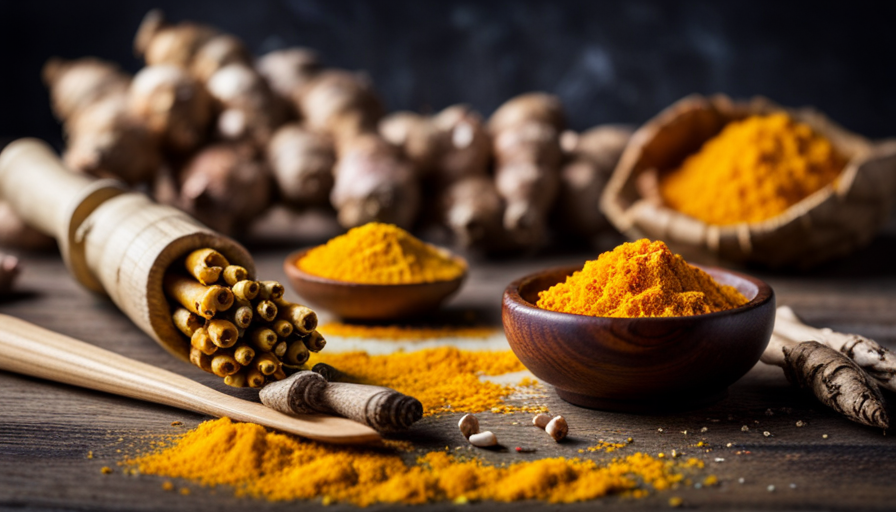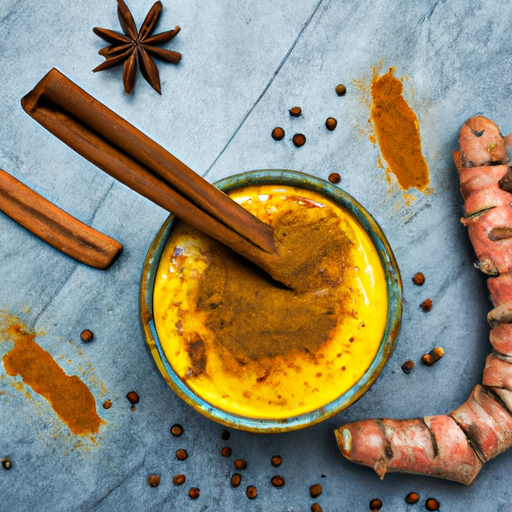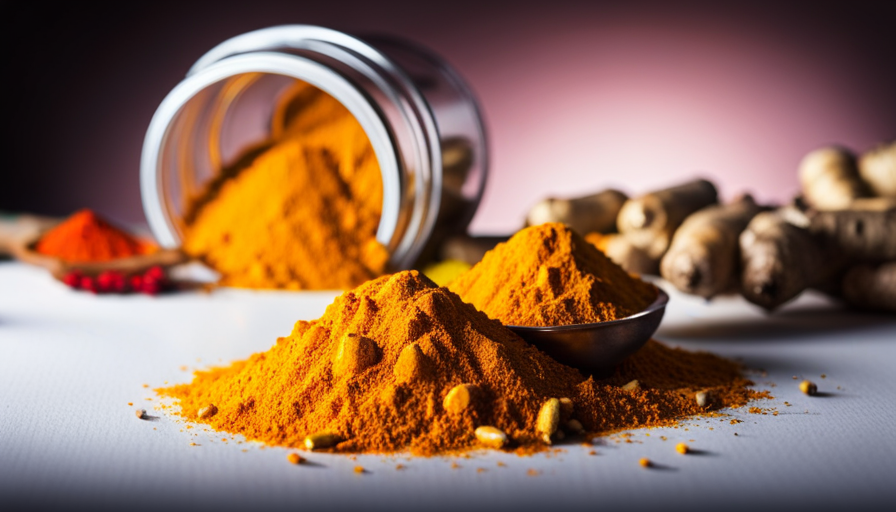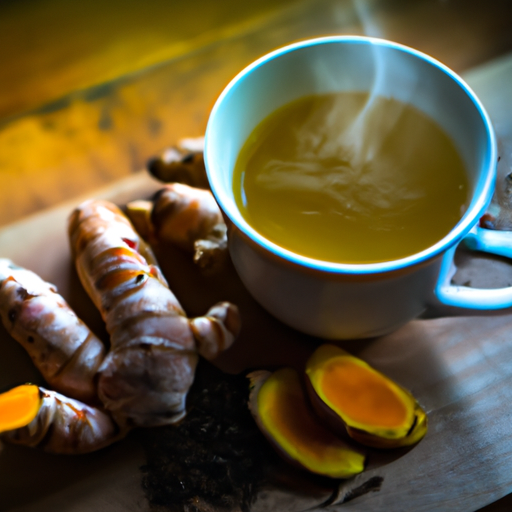You know that vibrant yellow spice that stains everything it touches? Well, that’s fresh turmeric root for you! It’s like a superhero in the world of culinary delights, bringing both flavor and health benefits to the table. If you’ve ever wondered how to incorporate this potent ingredient into your meals, look no further. In this article, I’ll guide you through a variety of creative and mouthwatering ways to use fresh turmeric root.
Get ready to sip on a Golden Turmeric Latte that will warm your soul and boost your immune system. Or blend up a refreshing smoothie infused with the earthy goodness of turmeric. Transform plain rice into a vibrant and fragrant dish with just a touch of this golden spice. And if you’re craving some roasted vegetables bursting with flavor, turmeric is here to save the day.
But it doesn’t stop there! We’ll also explore how turmeric can elevate marinades, oils, and dressings to new heights of deliciousness. And let’s not forget about the soothing and healing powers of turmeric tea. Plus, I’ll even share some sweet treats and face masks that will make your skin glow with radiance.
So, get ready to unleash the power of fresh turmeric root in your kitchen. It’s time to spice up your life and nourish your body with this golden gem. Let’s dive in and discover the endless possibilities of turmeric!
Key Takeaways
- Fresh turmeric root can be used to make a variety of beverages and dishes, such as Golden Turmeric Latte, turmeric smoothies, and turmeric rice.
- Turmeric has powerful anti-inflammatory and antioxidant properties, which can help reduce inflammation, boost the immune system, and improve digestion.
- Turmeric can be incorporated into meals by making turmeric roasted vegetables or using turmeric marinades to add flavor and spice to protein dishes.
- In addition to its culinary uses, turmeric can also be used in skincare products to improve skin health, fight acne-causing bacteria, soothe inflammation, and brighten the complexion.
Golden Turmeric Latte
Now, let me show you how you can make a delicious and soothing Golden Turmeric Latte using fresh turmeric root.
Turmeric lattes, also known as golden milk, have gained popularity due to their incredible health benefits. Turmeric contains a compound called curcumin, which has powerful anti-inflammatory and antioxidant properties. By incorporating turmeric into your daily routine, you can potentially reduce inflammation, boost your immune system, and improve digestion.
To make a turmeric latte at home, start by peeling a small piece of fresh turmeric root, around 1 inch in size. Grate the turmeric using a microplane or finely chop it.
In a small saucepan, heat 1 cup of milk (dairy or plant-based) over medium heat. Add the grated turmeric, along with a pinch of black pepper to enhance the absorption of curcumin. Stir well and let it simmer for about 5 minutes.
Next, add a sweetener of your choice, such as honey or maple syrup, to taste. You can also add other spices like cinnamon or ginger for extra flavor. Stir until the sweetener is dissolved.
Finally, strain the latte into a mug and enjoy!
Now that you know how to make a delicious turmeric latte, let’s move on to the next section about turmeric-infused smoothies.
Turmeric-infused Smoothies
Blend up a vibrant and invigorating smoothie that bursts with the golden goodness of turmeric-infused flavors! Adding fresh turmeric root to your smoothies not only enhances the taste but also provides numerous health benefits.
Turmeric is known for its anti-inflammatory properties, which can help reduce inflammation in the body and support overall wellbeing. Additionally, it’s a great source of antioxidants, which can help protect your cells from damage caused by free radicals.
To make a delicious turmeric smoothie, you can start with a base of your choice, such as almond milk or coconut water. Then, add a handful of spinach or kale for an extra boost of nutrients. Next, toss in a ripe banana for natural sweetness and creaminess. Finally, grate or chop fresh turmeric root and add it to the blender along with a pinch of black pepper to enhance the absorption of curcumin, the active compound in turmeric.
There are endless variations of turmeric smoothie recipes to suit your taste preferences. You can experiment with different fruits like mango, pineapple, or berries and add a spoonful of nut butter or a sprinkle of cinnamon for added flavor.
So, whip up a refreshing turmeric smoothie and get ready to enjoy a delicious and nutritious start to your day!
Now, let’s move on to the next section about ‘turmeric rice’ and discover another mouthwatering way to incorporate fresh turmeric root into your meals.
Turmeric Rice
To create a tantalizingly flavorful dish, infuse your rice with the vibrant hues and rich flavors of turmeric. Turmeric rice, also known as turmeric risotto or turmeric pilaf, is a delicious and nutritious way to incorporate fresh turmeric root into your meals.
Here are three ways to enjoy turmeric-infused rice:
-
Pair it with grilled chicken or fish: The earthy, slightly bitter taste of turmeric complements the smoky flavors of grilled meats or fish. The vibrant yellow color of the rice also adds a visually appealing element to your plate.
-
Serve it as a side dish: Turmeric rice can be a versatile accompaniment to a variety of main courses. Its mild flavor enhances the taste of curries, stews, or roasted vegetables, making it a perfect addition to any meal.
-
Use it as a base for stir-fries: Turmeric rice adds an extra layer of flavor and texture to stir-fries. Its slightly nutty taste pairs well with crisp vegetables and savory sauces, creating a satisfying and wholesome meal.
Now that you know how to make delicious turmeric-infused rice, let’s move on to the next section about turmeric roasted vegetables.
Turmeric Roasted Vegetables
Enhance your vegetable dishes by adding a pop of vibrant color and a hint of earthy flavor with turmeric roasted vegetables. Turmeric, a golden spice known for its numerous health benefits, adds not only a beautiful hue to your roasted veggies but also a distinct and savory taste.
To make turmeric roasted vegetables, start by preheating your oven to 425°F (220°C). Chop your preferred vegetables into bite-sized pieces—I recommend using a mix of carrots, cauliflower, and bell peppers for a colorful medley.
In a bowl, combine the chopped vegetables with olive oil, salt, pepper, and a generous amount of turmeric powder. Toss the vegetables until they’re evenly coated with the spice mixture.
Spread the vegetables in a single layer on a baking sheet and roast them in the preheated oven for about 25-30 minutes, or until they’re tender and slightly caramelized.
The result is a vibrant and flavorful side dish that pairs well with a variety of main courses, such as turmeric roasted chicken or turmeric spiced lentil soup.
As we move on to discussing turmeric marinades, you’ll find that this versatile spice can add a delightful twist to your favorite protein dishes.
Turmeric Marinades
One might argue that marinades are too time-consuming, but with a simple turmeric marinade, you can effortlessly elevate the flavor of your protein dishes. Turmeric isn’t just known for its vibrant color, but also for its numerous health benefits. When used as a marinade, it adds a unique earthy flavor and a hint of spice that pairs perfectly with a variety of ingredients. Here are four ways you can use turmeric marinades to enhance your dishes:
-
Turmeric Marinated Chicken: Combine turmeric, garlic, ginger, lemon juice, and olive oil to create a flavorful marinade for chicken. Let the chicken marinate for at least 30 minutes, or preferably overnight, before grilling or baking. The result is tender, juicy chicken with a golden crust and a deliciously aromatic taste.
-
Turmeric Marinade for Grilled Vegetables: Mix turmeric, cumin, coriander, lemon zest, honey, and olive oil to create a vibrant marinade for grilled vegetables. Toss your favorite vegetables in the marinade and let them sit for 15-20 minutes. Then, grill them to perfection for a colorful and flavorful side dish.
-
Turmeric Marinated Tofu: For a vegetarian option, marinate tofu in a mixture of turmeric, soy sauce, sesame oil, and lime juice. Let it marinate for at least 1 hour, then pan-fry or grill the tofu for a deliciously seasoned and protein-packed meal.
-
Turmeric Marinated Shrimp: Combine turmeric, paprika, garlic, lemon juice, and olive oil to create a tangy marinade for shrimp. Let the shrimp marinate for 15-30 minutes, then grill or sauté them for a quick and flavorful seafood dish.
By using these simple turmeric marinades, you can add a burst of flavor to your dishes without spending hours in the kitchen. Now, let’s move on to the next section about turmeric curry and explore another delicious way to use fresh turmeric root.
Turmeric Curry
After exploring the wonders of turmeric marinades, let’s delve into the realm of turmeric curry. As someone who loves experimenting in the kitchen, I’ve discovered that using fresh turmeric root in curries adds a vibrant and earthy flavor that’s hard to resist.
Not only does it enhance the taste, but it also offers a plethora of health benefits. Turmeric has been used in traditional medicine for centuries due to its potent anti-inflammatory and antioxidant properties. Its active compound, curcumin, has been linked to reducing the risk of chronic diseases such as heart disease, cancer, and Alzheimer’s. Incorporating turmeric into your diet through delicious curries is a great way to reap these benefits.
To prepare a turmeric curry, start by sautéing onions, garlic, and ginger in oil. Then, grate or finely chop the fresh turmeric root and add it to the pan, along with other spices like cumin and coriander. Allow the flavors to meld together, and then add your choice of vegetables, protein, and coconut milk. Let it simmer until everything is cooked to perfection.
Now, let’s move on to the next exciting topic: turmeric-infused oils and dressings!
Turmeric-infused Oils and Dressings
I love experimenting with flavors in my kitchen, and one ingredient that has quickly become a favorite of mine is fresh turmeric root. Not only does it add a vibrant color to any dish, but it also has a unique earthy flavor that pairs well with a variety of ingredients.
One way I like to incorporate turmeric into my meals is by creating my own infused oils and dressings. By infusing oil with fresh turmeric, you can add a subtle, aromatic flavor to your cooking. A turmeric dressing can bring a tangy and zesty kick to your salads and other dishes.
The versatility of turmeric in creating these unique and flavorful condiments is truly remarkable.
Create your own infused oils and dressings using fresh turmeric root
Transform your culinary creations into vibrant masterpieces by infusing your oils and dressings with the aromatic essence of fresh turmeric root.
Creating turmeric-infused vinegar is a simple and delicious way to add a burst of flavor to your salads and marinades. Just combine white vinegar with grated turmeric root and let it sit for a few weeks to develop its rich, earthy taste.
Another option is to incorporate turmeric into homemade mayonnaise for a creamy and tangy twist. Blend turmeric root with egg yolks, mustard, lemon juice, and oil for a vibrant and flavorful spread.
Discover the versatility of turmeric in creating unique and flavorful condiments that will elevate your dishes to new heights.
Discover the versatility of turmeric in creating unique and flavorful condiments
Now that you’ve learned how to create your own infused oils and dressings using fresh turmeric root, let’s dive into the versatility of turmeric in creating unique and flavorful condiments. Turmeric is not only a delicious spice, but it also offers numerous health benefits. Its active compound, curcumin, has anti-inflammatory and antioxidant properties that can support overall well-being. In fact, turmeric has been used in traditional medicine for centuries to treat various ailments. By incorporating turmeric into your condiments, you can add a burst of flavor while also reaping its health benefits. To give you some inspiration, I’ve created a table below showcasing three delicious condiments you can make using fresh turmeric root. So, let’s explore the exciting world of turmeric condiments and discover new ways to incorporate this incredible spice into our daily meals. Now, let’s move on to the next section about turmeric tea.
Turmeric Tea
Steep some freshly grated turmeric root in hot water to brew a warm and soothing cup of golden turmeric tea, like the sun gently rising to brighten your day.
Turmeric tea is not only delicious, but it also offers numerous health benefits. Turmeric contains a compound called curcumin, which has been shown to have powerful anti-inflammatory and antioxidant properties. These properties can help reduce inflammation in the body and protect against chronic diseases.
To make turmeric tea, simply grate about 1 teaspoon of fresh turmeric root into a mug and pour hot water over it. Let it steep for about 10 minutes to allow the flavors and health benefits to infuse into the water. You can also add other ingredients like ginger, lemon, or honey for added flavor and extra health benefits.
Turmeric tea is a great alternative to coffee or regular tea, especially if you’re looking for a caffeine-free option. It’s also a popular base for turmeric latte recipes, which combine the warm, spicy flavors of turmeric with creamy milk and sweeteners like honey or maple syrup.
As you sip on your cup of golden turmeric tea, you’ll not only enjoy its soothing warmth, but you’ll also reap the health benefits it offers. So, why not indulge in some turmeric sweets and desserts next? They’re the perfect way to satisfy your sweet tooth while still incorporating the goodness of turmeric into your diet.
Turmeric Sweets and Desserts
Indulging in turmeric sweets and desserts is a delightful way to satisfy your sweet tooth while still incorporating the goodness of this golden spice into your diet. Turmeric can add a unique flavor and vibrant color to your favorite treats, making them even more enticing. One popular option is turmeric ice cream, which combines the creaminess of ice cream with the health benefits of turmeric. You can either make it from scratch using fresh turmeric root or simply add turmeric powder to your favorite ice cream recipe. Another delicious choice is turmeric cookies. These cookies have a warm and slightly spicy flavor that pairs perfectly with a cup of tea or coffee. You can find various recipes online that use turmeric as a key ingredient, and they are often quite simple to make. By incorporating turmeric into your sweets and desserts, you can enjoy a guilt-free indulgence while reaping the many health benefits of this powerful spice. With the knowledge of how to use turmeric in your sweets, let’s now explore its potential in turmeric face masks and skincare.
Turmeric Face Masks and Skincare
Enhance your skincare routine with the natural glow and nourishing properties of turmeric face masks and skincare products. Turmeric, with its powerful anti-inflammatory and antioxidant properties, has been used for centuries in traditional medicine to treat various skin conditions. Incorporating turmeric into your skincare routine can help improve the overall health and appearance of your skin.
Here are four reasons why you should consider adding turmeric face masks and skincare products to your beauty regimen:
-
Brightens the complexion: Turmeric contains curcumin, a compound that helps reduce hyperpigmentation and evens out skin tone, giving you a radiant and glowing complexion.
-
Fights acne and blemishes: The antibacterial properties of turmeric can help combat acne-causing bacteria, reducing breakouts and preventing the formation of blemishes.
-
Soothes inflammation: Turmeric’s anti-inflammatory properties can help calm irritated and inflamed skin, making it ideal for conditions like eczema, rosacea, and psoriasis.
-
DIY turmeric skincare recipes: You can easily make your own turmeric face masks and skincare products at home using simple ingredients like turmeric powder, honey, yogurt, and coconut oil. These DIY recipes aren’t just cost-effective but also let you customize the ingredients according to your skin’s specific needs.
By incorporating turmeric into your skincare routine, you can enjoy the numerous benefits it offers for healthier, more radiant skin. So why not give it a try and experience the wonders of turmeric for yourself?
Frequently Asked Questions
Can fresh turmeric root be used in place of ground turmeric in recipes?
Can fresh turmeric root be used in place of ground turmeric in recipes? Absolutely! Using fresh turmeric root in recipes adds a vibrant flavor and a beautiful golden hue. Not only does it enhance the taste of your dishes, but it also offers numerous health benefits. Fresh turmeric root contains higher levels of antioxidants and curcumin, a compound with anti-inflammatory properties. However, it’s important to note that the flavor of fresh turmeric root is more intense, so adjust the quantity accordingly.
How do you store fresh turmeric root to keep it fresh for longer?
To maximize the shelf life of fresh turmeric root and keep it fresh for longer, there are a few storage tips you can follow. First, store the root in the refrigerator, preferably in a paper bag or airtight container to prevent moisture loss. This will help maintain its freshness and prevent it from drying out.
Additionally, avoid washing the root before storing it, as moisture can lead to spoilage. By following these simple turmeric root storage tips, you can enjoy fresh turmeric for an extended period.
What are the potential health benefits of consuming fresh turmeric root?
Consuming fresh turmeric root has potential medicinal properties that can benefit overall health. It contains a compound called curcumin, which has anti-inflammatory and antioxidant effects. Studies suggest that curcumin may help reduce the risk of chronic diseases such as heart disease, cancer, and Alzheimer’s.
While fresh turmeric root can be used in cooking, some people prefer taking turmeric supplements to ensure they’re getting enough curcumin. However, it’s important to consult a healthcare professional before starting any new supplement regimen.
Can fresh turmeric root be used in raw dishes or does it need to be cooked?
Raw vs cooked: Which is the best way to consume fresh turmeric root? Are you looking to maximize the health benefits of turmeric?
While cooking can enhance the flavor, consuming fresh turmeric root raw allows for the preservation of its powerful nutrients. To incorporate this vibrant root into your dishes, try grating it into salads, blending it into smoothies, or adding it to homemade dressings.
Get creative and explore unique recipes that highlight the distinct flavor of fresh turmeric root.
Are there any precautions or potential side effects to be aware of when using fresh turmeric root?
When using fresh turmeric root, it’s important to be aware of certain precautions and potential side effects.
While turmeric is generally safe for consumption, it may cause allergic reactions in some individuals. It can also interact with certain medications, so it’s advisable to consult with a healthcare professional if you’re taking any medications.
Additionally, consuming excessive amounts of turmeric may lead to digestive issues or an upset stomach. It’s always best to consume turmeric in moderation and monitor your body’s response.
Conclusion
In conclusion, incorporating fresh turmeric root into your daily routine can add a delightful touch of golden goodness to your life.
From the comforting warmth of a Golden Turmeric Latte to the vibrant flavors of turmeric-infused smoothies and rice, the possibilities are endless.
Not only does turmeric bring a burst of flavor to your meals, but it also offers numerous health benefits backed by scientific evidence.
So why not sprinkle some turmeric magic into your meals and skincare routine?
Embrace the golden goodness and let it work its wonders!










